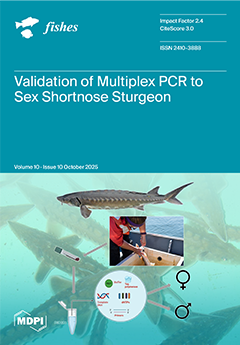Swimming ability is an important means for shrimp to survive in a water environment. To investigate the effects of different body lengths (L
1: 6.5 ± 0.25 cm, L
2: 8.8 ± 0.16 cm, and L
3: 11.5 ± 0.28 cm) and different measurement methods on the measured critical swimming speeds (U
crit), this study used experimental ecology methods to determine the U
crit of three body length (BL) groups of whiteleg shrimp (
Litopenaeus vannamei) at different time intervals (10, 20, 30, 40, and 50 min) and speed increments (1/2 BL s
−1, 3/4 BL s
−1, and BL s
−1) in a biological swimming channel. The results showed that the time interval and speed increment significantly affected the U
crit. In the small-body-length group (L
1), the U
crit of the shrimp decreased and then increased as the time interval increased, with no significant difference between time intervals or velocity increments. In the medium-body-length group (L
2), at the speed increment of 1/2 BL s
−1, the U
crit of the shrimp under the time interval < 40 min was significantly greater than that in the other treatment groups. At the speed increment of 1/2 BL s
−1, the U
crit of the shrimp decreased as the time interval increased. At the speed increment of 3/4 BL s
−1, the U
crit of the shrimp showed a trend of decreasing and then increasing with increasing time interval, and at a high-speed increment (BL s
−1), the time interval had no significant effect on U
crit. In the large-body-length group (L
3), at the speed increment of 1/2 BL s
−1, the U
crit of the shrimp under the time interval < 30 min was significantly higher than that in the other treatment groups. The effect of the time interval on U
crit was not significant at high-speed increments, and U
crit decreased with increasing time interval only at the speed increment of 1/2 BL s
−1. This study showed that, in the small-body-length group, the time increment has a more significant effect on the critical swimming speed, and, as the body length increases, both the time increment and velocity increment affect the critical swimming speed. When the time interval is 20 min and the speed increment is 1/2 BL s
−1, the measured U
crit is the closest to the appropriate value.
Full article





